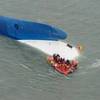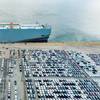Length 335m, width 43m, capacity over 100,000t for 8,600 standard containers – those are the key dimensions of the three containership newbuildings ordered today by Hapag-Lloyd. The vessels will be built by the South Korean Hyundai Heavy Industries. The first ship in the series will be delivered at the end of 2007 and the remaining two in 2008. Newbuildings must be ordered well in advance, as world production capacities for very large containerships are utilized up to 2008. Such a vessel then takes only about nine months to build.
"We want to make the most of the opportunities in the growing container transport market and continue to improve our position, and we are creating the prerequisites for this with our fleet expansion programme," explained Michael Behrendt, chairman of the executive board of Hapag-Lloyd AG, at the signing of the contracts for the new ships. Hapag-Lloyd again achieved double-digit growth and outpaced the market on average last year, transporting approx. 2.4m TEU.
About 72m standard containers (TEU) were carried globally by sea in 2004, 9% more than in 2003. Lined up in a row, these containers would stretch for approx. 420,000 km – further than the distance from the earth to the moon (385,000 km). Standard container transport volume is forecast to surge by about 30% or over 20m boxes to reach close on 95m by 2008.
Hapag-Lloyd is expanding its fleet from its current 51 to 61 ships up to 2008. Four vessels will be delivered in 2005, one in 2006, three in 2007 and two in 2008. "We will then have a homogeneous fleet of mega containerships, providing considerable cost advantages," Behrendt stated with satisfaction.
These vessels will not only be larger than the present "Hamburg Express" class – their emissions will be even lower thanks to the deployment of state-of-the-art, environment-friendly technology. The newbuildings will incorporate MAN diesel engines that more than meet the environmental protection regulations of the IMO, the International Maritime Organisation. They will consume less fuel and achieve a 30% reduction in nitrogen emissions. Consumption per container with a gross weight of about 15t is under 200g per tonne over 100 km. Ocean shipping has thus by far the lowest environmental impact of all means of transport.
The diesel engines installed in the new ships will have an output of 68,640 kW or 93,360 hp – sufficient power to supply a small town with electricity. They will give the vessels a speed of 25.2 knots, or about 50 km/h. The newbuildings will probably be deployed in Asia services.
Sponsored Content
Chris-Marine’s solutions help to prolong engine lifetime

AST is now AST Networks, bringing you remote connectivity wherever you are

March 2024
 Read the Magazine
Read the Magazine

 Read the Magazine
Read the Magazine
This issue sponsored by:

Inland Waterways Focus: The Pacific Northwest Columbia-Snake River System
Subscribe for
Maritime Reporter E-News
Maritime Reporter E-News is the maritime industry's largest circulation and most authoritative ENews Service, delivered to your Email five times per week












